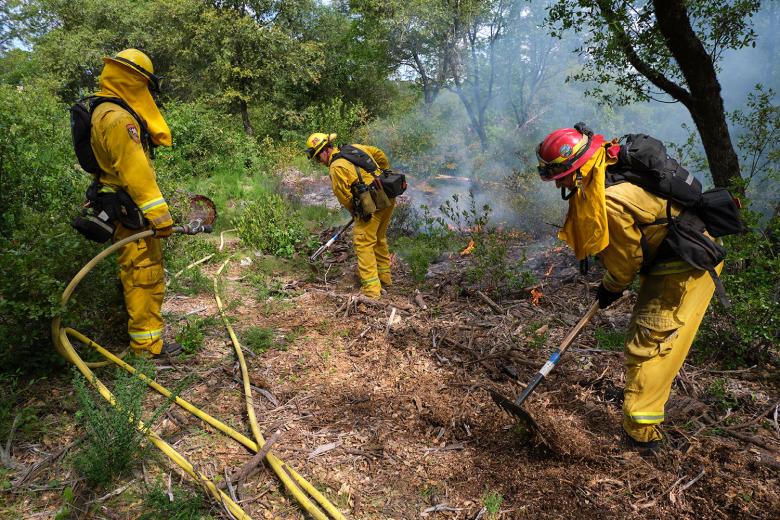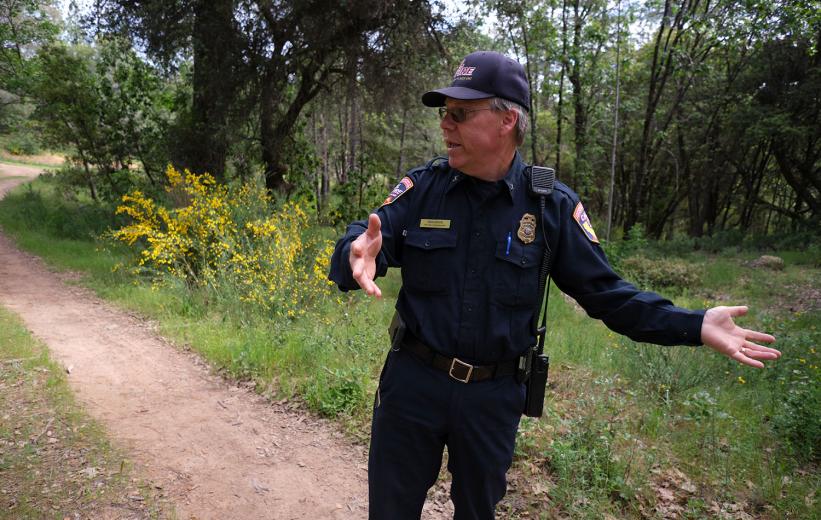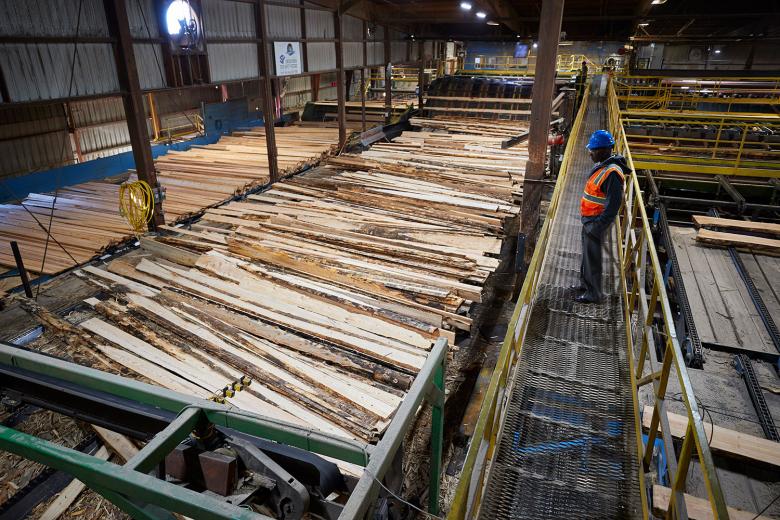Cal Fire Battalion Chief Sean Griffis spots smoke rising in the distance, about 10 miles from where he stands on a hill in Nevada County. He had approved a burn permit for a private property in that area, but there’s more smoke than he would expect. He calls the nearest fire station to check it out. He can never be too careful these days.
On this May morning, Griffis is with his four-man crew as they do cutting and pile burning, removing brush that had grown 8 feet tall in many places. The work is almost a daily occurrence in this part of the Sierra Nevada foothills during the spring. This job is on 200 acres at Reader Ranch, whose owners are clearing land for cattle grazing and to reduce wildfire risk. The ranch is in the footprint of the 49er Fire, which tore through Nevada County in 1988, causing what was, at the time, unprecedented damage.
“The operations chief, at that time for the fire, came out and was recorded as saying, this is the fire of the future, this is what we’re going to see from here on out,” says Griffis, who is in his 40th fire season. “Over the years, he has been proven correct. … The 49er Fire was for the folks before me, my predecessors, my mentors, my captains that I worked for, that was their fire of a lifetime. But now I’m having one of those every year.”
Most of the state’s largest wildfires have happened in the past 15 years. The last two years have broken records for death and destruction. Today’s conditions are unlike anything from the past. Warmer temperatures and decreased humidity — driven by climate change — and heavy vegetation in California’s forests can turn a spark into a massive threat. Flames burn hotter and move faster, creating infernos with their own weather patterns. Blazes burn during months when historically the fuels would have been too wet, like what happened with the Camp Fire in Butte County that burned most of Paradise in November 2018.
The U.S.’s approach to forests has long been a misinformed regime of fire suppression: extinguishing all flames as quickly as possible. Now California’s forests are overgrown tinderboxes-in-waiting. They’re also stocked with millions of dead trees from drought and bark beetle infestations. Additionally, the old practice of clear-cutting has led to evenly aged forests, which burn more severely once lit.
“The 49er Fire was for the folks before me, my predecessors, my mentors, my captains that I worked for, that was their fire of a lifetime. But now I’m having one of those every year.” Sean Griffis, battalion chief, Cal Fire
“Frankly, these fires are not an act of God,” says Malcolm North, a research scientist with the U.S. Forest Service and an affiliate professor of forest ecology at UC Davis. “They’re the result of 100 years of management decisions in which we didn’t quite understand the way the forest worked, and we were not necessarily doing the right thing for it.”
In order to get a grip on these crazy fires, experts say California needs to do more controlled burning and vegetation thinning, after years of putting every fire out and letting the landscape become dangerously overgrown. The state is ramping up these efforts, but it controls a small percentage of forested land and can only make so much of a dent. Of California’s 33 million acres of forest, federal agencies own 57 percent; families, Native American tribes and companies own 40 percent; and state and local agencies own 3 percent.
California also lacks the infrastructure to effectively process the waste from some of these forest management activities because the majority of its timber mills have closed in recent decades. Private industry might play a critical role, too, in preventing devastating fires, if it can do so without taking the state back to an era of rampant destruction of forests.
Let It Burn
A Cal Fire firefighter works on a controlled burn at Reader Ranch
in Nevada County.
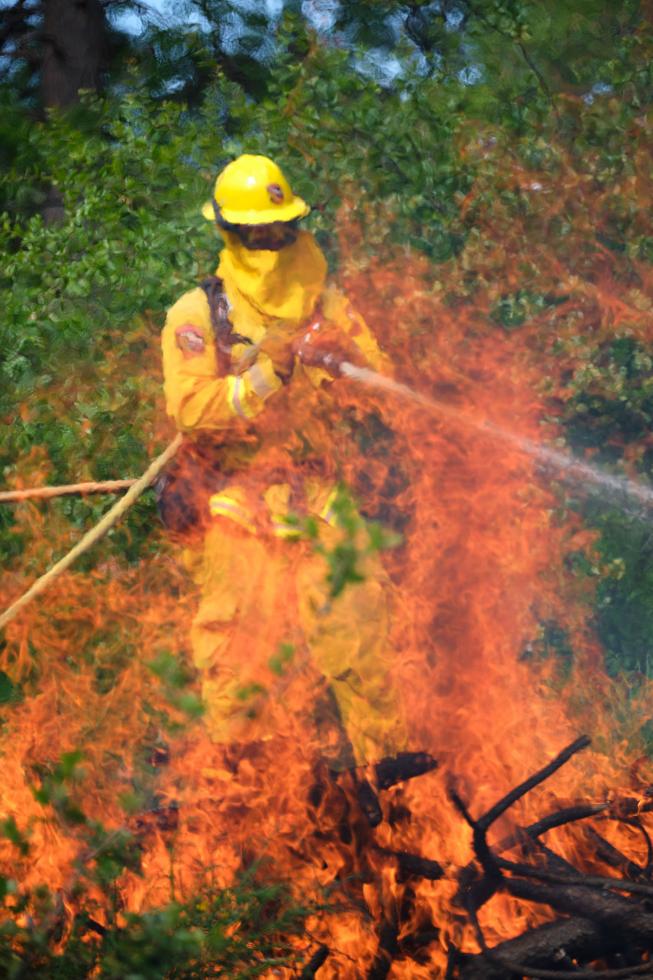
There’s a lot of work to do. In a 2012 study, North determined that historically — in the 1840s, before European arrival — about 500,000 acres burned on Forest Service land in the Sierra Nevada each year; in 2012, it was about 33,000 per year. “It’s like almost nothing,” he says. Griffis says Cal Fire’s Vegetation Management Program has only averaged about 13,000 acres annually.
In fall 2018, the Legislature allocated $200 million a year for the next five years for forest management, and Cal Fire has committed to a goal of managing 500,000 acres — primarily with controlled burning and thinning — per year eventually, as recommended in the “California Forest Carbon Plan,” released in 2018. The federal government has committed to the same. This work will be ongoing. “We have some challenges in what to do with the materials when we reach large-scale efforts — the 500,000 acres per year,” says Helge Eng, deputy director of resource management for Cal Fire. “That’s a lot of acres and a lot of wood coming out of the forest.”
Almost immediately after taking office, Gov. Gavin Newsom indicated that when it came to the wildfire crisis, he wasn’t messing around. He issued an executive order Jan. 8 to speed work on prevention projects in at-risk communities, and called for $105 million more in wildfire safety funding. Cal Fire identified 35 projects in its “Community Wildfire Prevention & Mitigation Report” to implement immediately, noting how “[m]ore than 25 million acres of California wildlands are classified as under very high or extreme fire threat, extending that risk over half the state.” Projects include the removal of dead trees, clearing vegetation and the creation of fuel breaks, among other activities.
“It’s really a matter of using all the tools at our disposal,” Eng says. “It’s not just fuel reduction. It’s ingress and egress to communities so that people can escape if a catastrophic wildfire should occur. It’s home hardening — essentially fireproofing homes — that could be both existing [homes] and strengthening the building code for new homes, and certainly land-use planning is an essential aspect of it.”
“Frankly, these fires are not an act of God. They’re the result of 100 years of management decisions in which we didn’t quite understand the way the forest worked, and we were not necessarily doing the right thing for it.” Malcolm North, research scientist, U.S. Forest Service
One way to increase the scale of forest management is to let nature do some of the work, by allowing fires to burn in remote wilderness areas as managed wildfires, then concentrate mechanical thinning and controlled burns where wildland and development intersect, where people live. North says Yosemite National Park has had let-burn areas for several decades, and when the Rim Fire burned into Yosemite’s Aspen Valley in 2013, “The wildfire burned in there, and in many places it actually dropped out of the tops of the trees, burned along the ground and did what it was supposed to do. So there’s pretty good evidence that when you restore these fire systems, you can get fire back as a beneficial force into the forest. But you have to deal with the fuel problem you had from decades of putting out all the fires first.”
California’s forests are going to burn, North says. “The one thing we do know … is even though we’ve gotten better with aircraft and techniques, you cannot control fire in the system,” he says. “You’re going to get fire eventually. So we really have to make the decision: Do we always want to be doing fire suppression, and then we’re dealing with triage all the time, or do we want to start being proactive and being the agent that sometimes puts fire out on the landscape, but in conditions that we want?”
Trying to Build a Restoration Economy
On a windy March afternoon, head sawyer Robert Newton sits in a control room inside one of two sawmills at Sierra Pacific Industries in Lincoln, loading logs into a “head rig” machine where a computer takes over. It scans the logs, sending them into a series of saws to be broken down into sections, before moving into another computer-run sawing center. “You have the operators manning the machines, but the computer is making the [cut] decision, and the operator is overseeing the decisions,” explains Mark Luster, the community relations manager for Sierra Pacific.
Mike Mitzel has come down from Sierra Pacific’s headquarters in Anderson. He has worked in the timber industry for 44 years, 27 of those with Sierra Pacific; he’s now the Northern Sierra area manager, overseeing 658,000 of the company’s 1.7 million acres in California. He grew up in Paradise, and houses he once lived in burned down during the Camp Fire. “It’s just a catastrophic loss,” Mitzel says. His first job in the woods was in Stirling City, a tiny community near Paradise.
Robert Newton works inside a control room at a Sierra Pacific
sawmill in Lincoln. The company owns 10 sawmills in California.
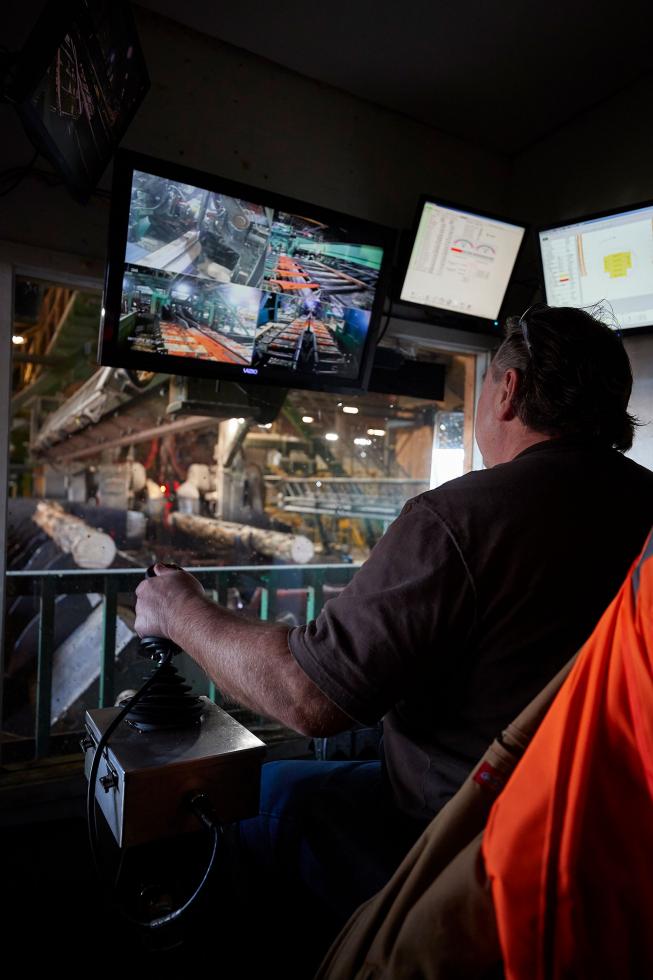
At its height in 1955, California’s timber industry operated more than 700 sawmills. Then in the 1990s, these companies faced off with environmentalists over the clear-cutting of old-growth forests and the plight of the spotted owl — a turbulent time known as the timber wars. “You may recall people chaining themselves to trees in the redwood country,” says Rich Gordon, president and CEO of the California Forestry Association, a Sacramento-based trade group for timber companies and private forestland owners. “Someone named Julia ‘Butterfly’ [Hill] lived in a tree for two years. Folks were actually murdered. My predecessor, a guy by the name of Gil Murray, opened a package in the office at the time for the Forestry Association. It was a bomb from the Unabomber.”
It was a tense time, leading lawmakers to adopt strict forest practice regulations. “I always like to point out if you buy lumber from California, you’re buying the most environmentally friendly lumber in the world,” Gordon says. Large multinational and publicly traded companies refused to abide by the rules, sold their property and moved operations elsewhere. Fewer than 30 sawmills now operate.
The decline in commercial timber activity combined with 100-plus years of fire suppression practices (see sidebar on page 64) has led to California’s forests becoming increasingly dense. “Instead of 40 trees to an acre, which was the natural state at one point, we now have 400, 500, 800 trees to an acre, and that is a huge factor in our fires,” Gordon says. Historically, with fewer trees to an acre, flames tended to stay low to the ground rather than climb into the canopy. In these modern dense, hot and dry forests, the fire is more likely to rise to the overstory, with blazes moving rapidly and embers flying far distances. They are more likely to become mega-fires on a warpath.
“People don’t realize how much vegetation grows over time,” says Mitzel. “When I moved up there back in the ’60s, I could go up there and fish a lot of streams … Right before the [Camp Fire], driving through town, you couldn’t even get close to the water because they’re just overgrown with vegetation.”
As government works to do its part to deal with fire risk, private industry is starting to play a critical role too. For instance, in May 2018, Sierra Pacific thinned trees and removed ground vegetation on its property adjacent to Paradise Lake, connecting with previous fuel reduction activities between the lake and the community of Stirling City. They took this action to protect their property from human activity at the nearby lake. Dubbed “fuel breaks” in industry speak, these sites give firefighters a place to stage equipment and personnel. During the Camp Fire, which started on federal land, the flames reached the fuel break next to the lake and slowed down, where Cal Fire took action to stop the fire’s northerly spread, helping save Stirling City and other nearby residences.
“This thing wasn’t exactly designed to save those houses,” Mitzel says. “It was really to protect us from them. There’s a lake in the background — Paradise Lake — and this gets a lot of recreation use, and we wanted to make sure that somebody that was down here recreating didn’t accidentally start a fire and end up burning our property.” Sierra Pacific has increased its fire reduction efforts and is coordinating with government agencies to design fuel breaks.
“You bring employment into rural areas. In that part of rural California, I mean, there’s great trout fishing, but the population’s not growing in those neighborhoods. You would certainly get local support for the work.” Peter Paul, CEO, West Biofuels
Because of their effectiveness, Gordon says his association would like fuel breaks to be allowed as an exemption to what’s called a Timber Harvest Plan. A THP needs approval from several agencies, takes months to develop, and can run from $30,000 to more than $100,000, he says; an exemption would hasten the process. “We’re hopeful one role private industry can play is to be more proactive and work with the state and the dollars that are available for forest management to create more of those kinds of fuel breaks, particularly around communities at risk,” he says.
As the state grapples with how to increase pace and scale, some environmentalists have expressed concern that thinning activities could lead to the logging approach of the past. The biggest trees are the most fire resistant — but they’re also worth the most money. They worry that calls for increased thinning are really efforts to increase widespread logging. The problem trees that actually need to be removed are small trees, which flames use to climb up into the canopy. “Of course, the downside is they don’t have much of an economic value … usually there’s no way for these trees to pay their way out of the woods,” North says.
Smaller trees can become composite material for things such as siding, flooring and ceilings. Thinned debris could become sawdust or landscape bark. Some material could be ground up and left to biodegrade, which enriches the soil but also remains as a fuel and releases gases as it decomposes. Sawmills would be one destination for this material, but they’re already at capacity. The infrastructure for processing wood has substantially dropped over the past few decades; the mills that still exist are often saturated with fire-killed trees.
“The lack of timber that was coming out of the forests [in the 1990s] reduced the amount of mills that are available now, so that’s an industrywide thing; mills just disappeared because there wasn’t any wood to feed the mills,” says Jennifer Hinckley, a fire management specialist formerly with the U.S. Forest Service and now with the U.S. Fish and Wildlife Service. “So now that we’re ramping back up again, the mills that used to be there aren’t there anymore.”
To handle all the work California wants to do, the forest-products industry would likely need to expand, but that won’t happen without a long-term business opportunity. It’s expensive to open a shuttered sawmill, upgrade to increase capacity or build a new one. “If folks know they have assurance they’re going to have the raw material, they are going to reinvest in the infrastructure that they need,” says Luster, of Sierra Pacific. A sawmill costs about $80 million to $100 million to build. “In order to do that, you’re going to need to know that you’re going to have to have enough supply of materials that’s going to be there for 20 years, 30 years down the road.”
Then there’s biomass, which has been seen as a longshot by some, but proponents say it could become a primary market to accommodate discarded forest thinnings. The industry has struggled to gain a foothold because bioenergy is more expensive than other renewable sources such as wind and solar. There are transportation costs, for example, to get the feedstock out of the forests and to a biomass plant.
Biomass companies want the opportunity to handle this material, says Peter Paul, CEO of West Biofuels, which has a research and development facility in Woodland. The Petaluma-based company, founded in 2007, has worked on several public-private partnerships to develop its advanced technologies and evaluate their commercial feasibility. Paul says his company has a “21st century answer” to the forest-waste problem that meets California emission standards.
“We need forest thinning crews, we need heavy-equipment operators, we need forest technicians, we need environmental planners, we need people that can do the mechanical and logistical work, we need engineers.” Steve Frisch, president, Sierra Business Council
The company is building a 3-megawatt commercial plant, called the Hat Creek BioEnergy facility, in Shasta-Trinity National Forest, with partial funding from the California Energy Commission. It’s projected to be operational in 2021. Paul, originally from New Hampshire where the paper and pulp industry once thrived, says biomass will create much-needed middle-class jobs. “You bring employment into rural areas,” he says. “In that part of rural California, I mean, there’s great trout fishing, but the population’s not growing in those neighborhoods. You would certainly get local support for the work.”
Shifting at least some of the financial burden of forest management to private industry could lead to innovative ways to increase the pace and scale. The Blue Forest Conservation, for example, has developed the Forest Resilience Bond, a public-private partnership in which an organization can use bond money to hire private contractors to do fire prevention or restoration work much faster than the government can. The pilot project launched in 2018 in Tahoe National Forest.
Steve Frisch, president of the nonprofit Sierra Business Council in Truckee, agrees that forest management activities can reinvigorate rural communities by launching a restoration economy, instead of the resource extraction one that California has relied on for so long.
“We need forest thinning crews, we need heavy-equipment operators, we need forest technicians, we need environmental planners, we need people that can do the mechanical and logistical work, we need engineers,” he says. “If we’re also going to be looking at bioenergy, we need energy industry workers who could be replaced from fossil fuels to bioenergy who could be moving from one industry that is declining to another industry that could be scaling to meet the challenge.”
Who Will Lead the Way?
Engineer Brandon Yurek, of Cal Fire, moves wood debris into a
pile in preparation for a controlled burn at Reader Ranch in
Nevada County in May.
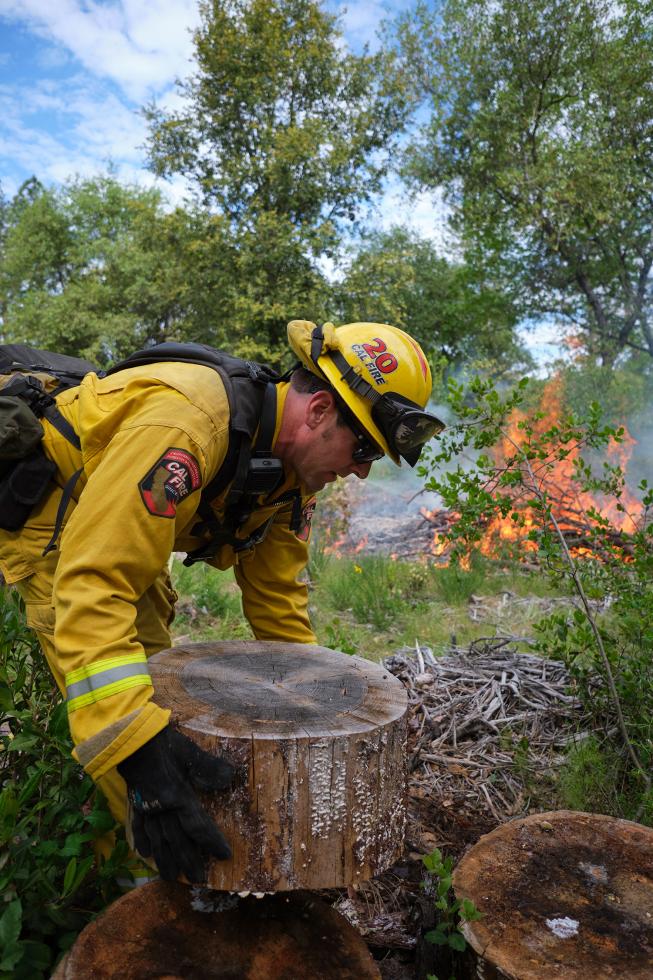
“Six, seven years ago, most people just said, no, my property’s fine, don’t bother me,” Griffis says. “But after five years of consecutively larger and more damaging fires, the interest is now coming out. We are getting more people contacting us, saying, hey, what can I do, what can you do, to get my property cleared?”
In September, Gov. Jerry Brown signed legislation requiring the Cal Fire Office of the State Fire Marshal, working with the Statewide Training and Education Advisory Committee, to create a certification program for burn bosses to allow private individuals to become certified to burn. Currently, the state government uses only its own personnel to conduct prescribed burns, and having more certified burn bosses will help the state reach its statewide prescribed burn goals, according to the legislation. The law requires that this curriculum be developed by 2021.
Cal Fire claims to have the most firefighter boots on the ground of any state in the country and the largest aviation fleet to combat wildfire in the world. The agency is replacing its aging helicopters with Black Hawks, worth a total of $300 million, that have been converted to carry crews and water and perform fire rescues. But as it continues to add personnel and state-of-the-art equipment, it also is investing in the proactive forest management strategies that can help prevent inevitable fires from turning into massive destruction.
Cal Fire’s Eng, who has more than 25 years of forestry experience, says despite the challenges, he’s encouraged that various stakeholders are finding common ground. In doing so, they’re gleaning lessons from the past when Native Americans utilized fire as a tool and nature was allowed to run its course, a time when the forests were healthier.
“California is always 10 years ahead of everybody else, and I think we are actually truly blazing a trail here for what other states will follow,” Eng says.“We’re forced to confront this crisis in our forests, [and] we’re making progress. I’m hopeful. I’m optimistic. In five years, we’ll see a difference in our forests, and I think it will be for the better.”
Recommended For You
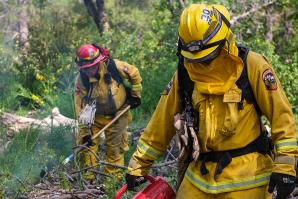
Beating the Burn: How We Got Here
An abbreviated history of firefighting efforts in the Golden State
When lightning sparked fires in the 1850s, they were left to burn, naturally clearing out dry fuels. Just a few decades later, officials started shifting toward a strategy of fire suppression.

After the Fire
A muralist and photographer team up to paint and memorialize the ruins of the Camp Fire in Paradise
Artist Shane Grammer knew he had to paint the brick chimney the moment he saw a photo of it — the only part of a friend’s house in Paradise still standing after the Camp Fire devastated the town. The fire started tearing through the area on Nov. 8, 2018, becoming the deadliest and most destructive wildfire in California history.
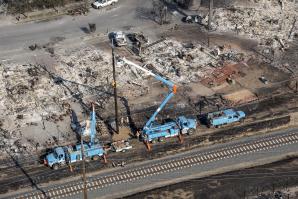
California Utilities Want Customers to Help Pay Wildfire Damages
Minutes before President Donald Trump landed in California on March 13, the most powerful politicians in the state sent out a public statement that had nothing to do with him and would garner little attention.
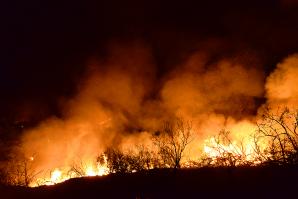
In California’s Wildfires, a Looming Threat to Climate Goals
Beyond the devastation and personal tragedy of the fires that have ravaged California in recent months, another disaster looms: an alarming uptick in unhealthy air and the sudden release of the carbon dioxide that drives climate change.



